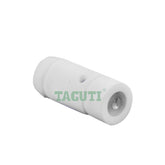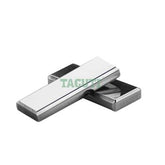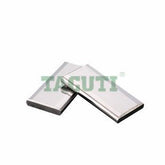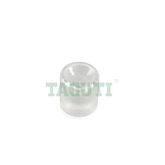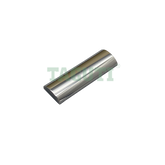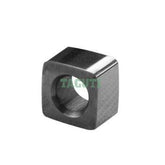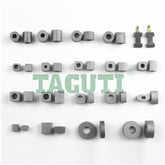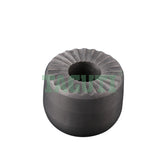The importance of power feed contact in slow wire EDM cutting
Slow wire EDM cutting is a high-precision special processing technology, widely used in mold manufacturing and precision parts machining. As a key component in slow wire EDM machines, the power feed contact plays a crucial role. It not only directly affects machining efficiency, accuracy, and surface quality, but also relates to equipment stability, electrode wire lifespan, and processing costs.
A. Ensuring stable current transmission: the core foundation of machining accuracy
1. High-quality electrical conductivity and material selection
Power feed contact are typically made of highly conductive materials such as Oxygen-Free High Thermal Conductivity copper (OFHC), brass, and plated materials (e.g., tungsten or molybdenum). Differences in conductivity, hardness, and wear resistance among these materials directly impact the stability of current transmission. For example, OFHC has high conductivity but is relatively soft, making it suitable for low-current precision machining. Tungsten-plated power feed contact, on the other hand, offer high hardness and wear resistance, making them suitable for high-current, high-efficiency machining.
Material purity is crucial: Impurities or coarse grains may lead to increased local resistance, causing current concentration and arc burns, affecting processing accuracy.
2. Current uniformity and discharge stability
The contact area and pressure between the power feed contact and the electrode wire (e.g., brass wire, zinc-coated wire) must be precisely controlled. Poor contact can lead to uneven current density, localized overheating, unstable arc discharge, burns on the workpiece surface, and increased electrode wire loss.
The contact surface of the power feed contact is usually an arc surface, and precision grinding is used to ensure uniform contact between the electrode wire and power feed contact, reduce contact resistance, and improve discharge stability.
3. Reduce power loss and heat
Low-resistance power feed contact can significantly reduce power loss and improve energy efficiency. For example, the surface resistance of power feed contact using coating technology can be reduced to the μΩ level, reducing heat generation and extending the life of the electrode wire.
The thermal conductivity of power feed contact also affects current stability. High thermal conductivity materials can quickly dissipate heat, preventing localized overheating that could lead to material performance degradation.
B. Maintaining processing stability: ensuring high precision and high reliability
1. Electrode wire positioning and guiding
Power feed contact not only carries the current but also positions and guides the electrode wire. Its structural design limits lateral vibration of the wire electrode, ensuring that wire runout deviations during machining are within μm, thus avoiding machining errors caused by wire vibration.
In high-precision machine tools, power feed contact often used in conjunction with tension devices to dynamically adjust the tension of the electrode wire to further reduce vibration.
2. Prevent electrode wire breakage and damage
Unstable current or excessive contact pressure can cause local overheating of the electrode wire, resulting in stress concentration and increasing the risk of breakage. High-quality power feed contact reduces surface damage (such as corrosion pits and microcracks) on the electrode wire by providing uniform conductivity and optimizing contact pressure, extending its service life.
Some power feed contact adopts a kind of segmented design to conduct current in sections, reducing single-point wear and lowering the probability of wire breakage.
3. Adapt to complex processing conditions
In complex working conditions such as taper cutting and deep hole machining, power feed contact must have good adaptability. For example, an adjustable power feed contact can adapt to electrode wires with different inclination angles, ensuring stable current transmission and avoiding machining defects caused by angle deviation.
C. Ensuring machining accuracy and surface quality: the core elements of precision manufacturing
1. Precise control of discharge energy
The stability of power feed contact directly affects the waveform and energy distribution of the discharge pulse. Stable current transmission ensures consistent energy during each discharge, enabling micron-level material removal and improving machining accuracy.
For example, in precision mold processing, poor performance of power feed contact may cause fluctuations in the discharge gap, resulting in workpiece size deviations exceeding ±0.005mm.
2. Surface roughness optimization
The stability of current transmission directly affects the uniformity of discharge points. High-quality power feed contact can reduce the random distribution of discharge points and lower the surface roughness (Ra) of the workpiece. For example, in mirror finishing, the precise design and low resistance of power feed contact can achieve an ultra-smooth surface with Ra ≤ 0.2μm.
3. Reduce secondary discharge and streak defects
Wear or dirt accumulation in power feed contact can cause secondary discharges (repeated arc discharges in the machined area), resulting in surface streaks or burns. Regular cleaning and replacement of the power feed contact can avoid these defects and ensure a consistent workpiece surface.
D. Extend the life of electrode wire and equipment: reduce overall costs
1. Improve electrode wire life
Contact wear between power feed contact and electrode wire is one of the causes of wire loss. Using wear-resistant materials (such as cemented carbide and surface coatings) or optimizing the arc design of the contact area can significantly reduce wire wear and extend the service life by more than 30%.
2. Protecting core components of machine tools
Stable current transmission reduces load fluctuations on key components such as the pulse power supply and servo system, extending the overall life of the equipment. Power feed contact's support of the electrode wire reduces wear on the wire guide and tension pulley, reducing equipment maintenance frequency.
E. Adapt to diverse processing demands: flexibility and compatibility
1. Multi-material electrode wire adaptation
Electrode wires made of different materials (such as brass, zinc-coated, and tungsten) have significantly different conductive properties. Power feed contact must be compatible and adapt to the conductive and wear characteristics of different electrode wires through material selection and surface treatment techniques (such as plating and polishing).
2. Multi-parameter processing scenarios
When switching between high-current roughing and low-current finishing, Power feed contact block must maintain stable performance. Some high-end wire EDM machines use dynamic contact pressure adjustment technology on power feed contact, which automatically optimizes contact conditions based on machining parameters, taking into account both efficiency and precision.
3. Special application scenario extension
In aerospace, medical and other fields, power feed contact needs to meet special requirements, such as corrosion resistance (for processing titanium alloys), high temperature stability (for processing cemented carbide), etc., which are achieved through customized materials and designs.
F. Maintenance and intelligent management: Improve processing efficiency and reliability
1. Regular inspection and maintenance
Wear, oxide buildup or cracks on power feed contact surface can significantly affect performance. The following maintenance strategies are recommended:
Regular inspection: Use a microscope to observe the wear of the contact surface and record the wear depth (usually replacement is required if it exceeds 0.2mm).
Cleaning and lubrication: Use special cleaner to remove corrosion products and apply conductive grease to reduce friction.
Wear compensation: Some machine tools have an automatic compensation function for conductive block wear, which adjusts processing parameters through software to make up for performance degradation.
2. Intelligent monitoring technology
Modern wire-cut machine tools are equipped with integrated conductive block status monitoring systems, which use sensors to detect current fluctuations, contact resistance, temperature and other parameters in real time, provide early warnings of potential faults, and implement preventive maintenance.
G. Industry trends and technological innovation
1. New material applications
Research and develop higher performance materials, such as carbon fiber composite power feed contact (high strength and low resistance) and diamond-coated power feed contact (super hard, low friction), to further improve wear resistance and conductivity.
2. Adaptive conductive technology
Develop intelligent power feed contact that can dynamically adjust contact area and pressure according to processing conditions, optimize current distribution, and adapt to complex processing scenarios.
3. Green manufacturing direction
By optimizing power feed contact design, energy consumption is reduced, electrode wire waste is reduced, and environmental protection requirements are met.
Conclusion
Although power feed contact in wire-cut machining is a "small component," its performance directly impacts the stability, precision, and efficiency of the entire machining system. From current transmission, machining stability, precision assurance, to cost control, the power feed contact's role permeates the entire machining process. Through rational material selection, precision design, intelligent monitoring, and scientific maintenance, the value of power feed contact can be fully utilized, helping companies achieve their goals of high-quality, high-efficiency, and low-cost precision machining. In the high-end manufacturing sector, the optimization of power feed contact has become a key technology for enhancing competitiveness, worthy of the attention of companies and practitioners.
Power feed contact
- $14.95
- $14.95
- Unit price
- / per
- $10.50
- $10.50
- Unit price
- / per
- $4.95
- $4.95
- Unit price
- / per
- $15.50
- $15.50
- Unit price
- / per
- $13.50
- $13.50
- Unit price
- / per
- $13.50
- $13.50
- Unit price
- / per
- $27.50
- $27.50
- Unit price
- / per
- from $1.99
- from $1.99
- Unit price
- / per
- $31.50
- $31.50
- Unit price
- / per
- $13.50
- $13.50
- Unit price
- / per
- $14.00
- $14.00
- Unit price
- / per
- $7.50
- $7.50
- Unit price
- / per
- $68.00
- $68.00
- Unit price
- / per
- $4.95
- $4.95
- Unit price
- / per
- from $32.50
- from $32.50
- Unit price
- / per
